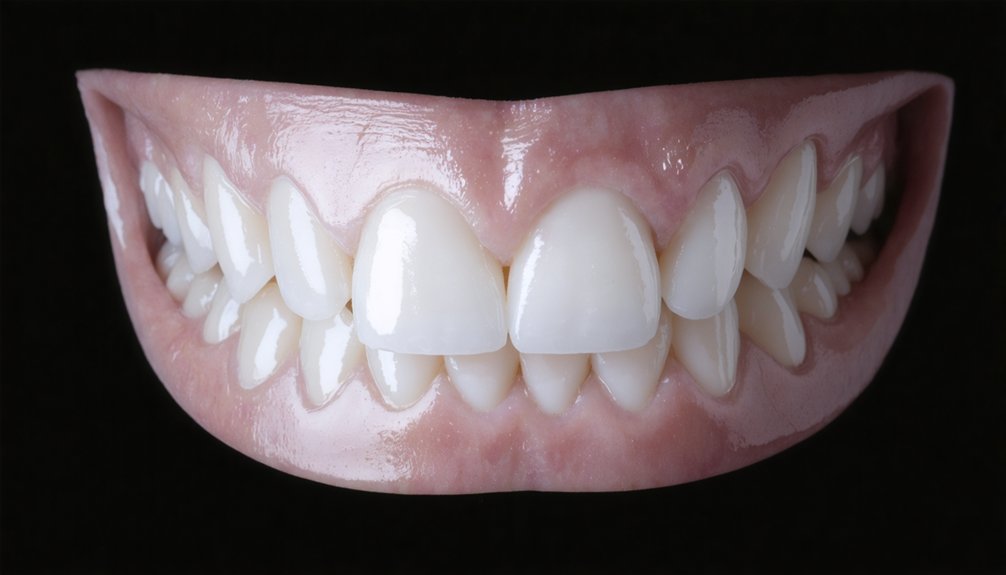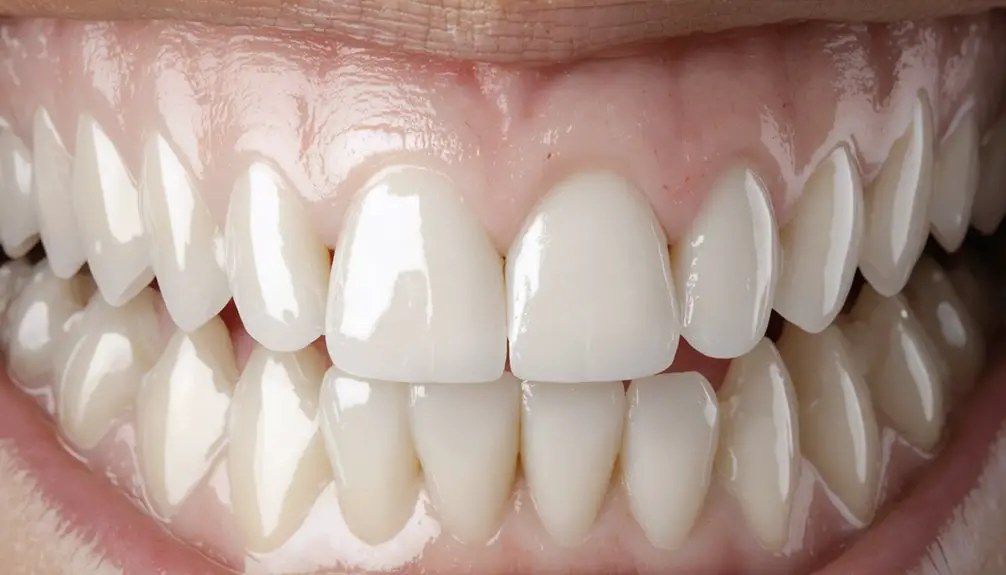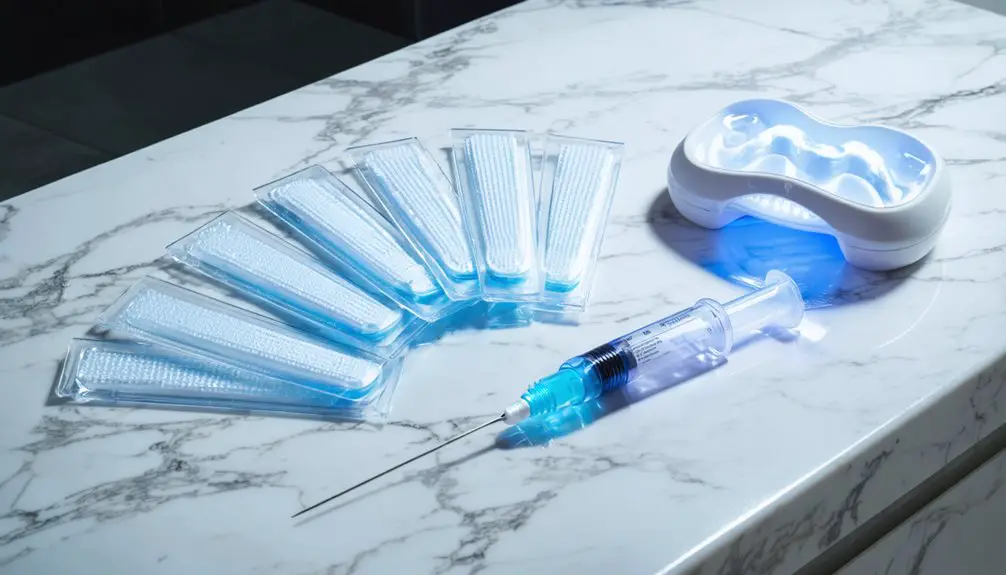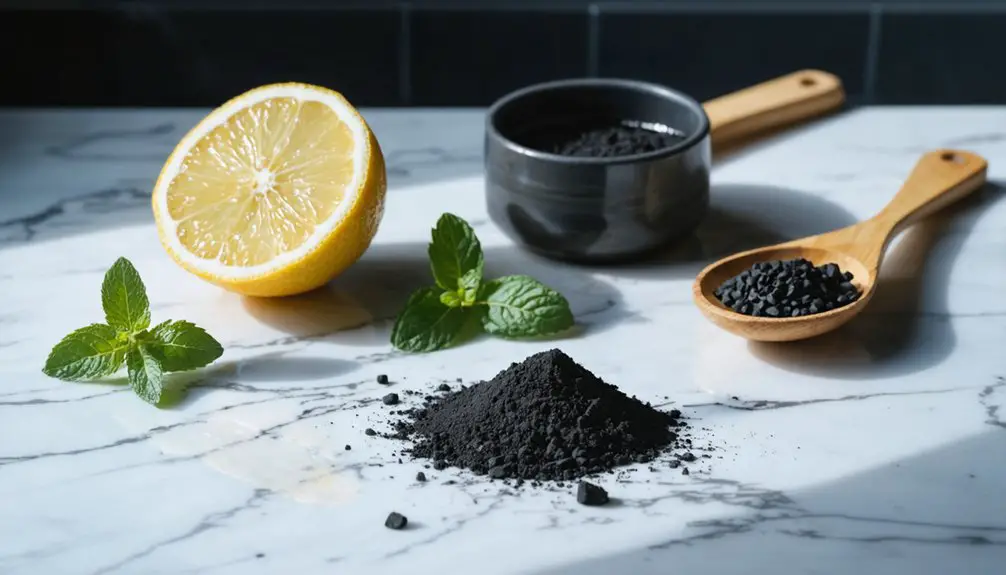You’ll find today’s teeth whitening landscape transformed by AI-powered solutions and smart LED technology that deliver personalized treatments with up to 10 shades of improvement. Professional-grade home systems now offer dental-office quality results, while natural alternatives like activated charcoal provide gentler options for sensitive teeth. Eco-friendly innovations and subscription-based services make maintaining your bright smile more convenient than ever. Discover how these advanced options can help you achieve your perfect shade.
Key Takeaways
- AI-powered teeth whitening systems now offer personalized treatments with real-time adjustments based on individual dental profiles and sensitivity levels.
- Dual-action LED technology combines blue and red light therapy with wireless mouthpieces for improved comfort and effectiveness.
- Natural whitening alternatives using plant-based ingredients like coconut oil and activated charcoal are gaining popularity among sensitivity-prone users.
- Subscription-based whitening services provide customizable plans with professional-grade products and regular delivery of whitening materials.
- Smart device integration enables mobile app tracking, shade analysis, and Bluetooth-enabled trays for convenient at-home whitening treatments.
The Rise of AI-Powered Teeth Whitening Solutions
As artificial intelligence continues revolutionizing dental care, AI-powered teeth whitening solutions have emerged as a game-changing advancement in cosmetic dentistry. Through sophisticated AI algorithms, your treatment can now be precisely tailored to your unique dental profile, maximizing both safety and results.
AI-driven teeth whitening technology personalizes treatments to each patient’s dental profile, revolutionizing cosmetic dentistry with enhanced safety and optimal results.
You’ll experience enhanced whitening customization through AI-driven analysis of your dental scans and photos, which determines the ideal protocol for your specific needs. Professional treatments can achieve up to 8 shades brighter results in a single session.
Treatment personalization extends to real-time adjustments of light activation and bleaching agent concentrations, ensuring maximum effectiveness while protecting your enamel. Predictive analytics assess your likely response to treatment based on factors like enamel condition and stain type, creating a safer, more efficient whitening experience.
The integration of smart light technology further reduces sensitivity and discomfort, delivering the best results in shorter treatment times. The latest systems include whitening progress tracking features that provide daily photo updates and reminders through mobile apps.
Natural and Peroxide-Free Whitening Alternatives
If you’re seeking gentler teeth whitening options, plant-based ingredients like coconut oil, turmeric, and fruit enzymes offer peroxide-free alternatives to traditional bleaching methods.
These natural solutions can be particularly beneficial if you experience tooth sensitivity or prefer to avoid chemical whitening agents. Activated charcoal powder can effectively absorb surface stains and impurities from teeth when used properly.
You’ll find that combining methods like oil pulling with fibrous fruits and vegetables provides a thorough approach to natural teeth whitening while supporting overall oral health. Daily use of coconut oil pulling helps eliminate harmful bacteria and plaque that contribute to tooth discoloration.
Plant-Based Whitening Ingredients
The growing interest in natural dental care has sparked innovative research into plant-based teeth whitening alternatives.
Banana peel benefits include natural bleaching compounds like alkaloids and flavonoids, while activated charcoal effectiveness stems from its ability to physically adsorb surface stains without harsh chemicals.
You’ll find various plant-derived ingredients that work through different mechanisms.
Malic acid from apples and lemons helps break down extrinsic stains, while rosella extracts alter tooth pigmentation through pH effects. Baking soda pH helps maintain optimal oral conditions for these natural ingredients to work effectively.
Scientific evidence suggests these methods are less regulated than traditional pharmaceutical whitening products.
Natural compounds like saponins and green pear extracts are emerging as promising whitening agents.
However, it’s essential to recognize that while these alternatives are gentler than peroxide treatments, they’re most effective on surface stains and anterior teeth.
For ideal results, consider products that combine multiple plant-based ingredients with mild abrasives.
Sensitivity-Safe Treatment Options
People with tooth sensitivity can now choose from numerous gentle whitening solutions designed specifically for their comfort.
Today’s sensitivity solutions include professional treatments with customized peroxide concentrations and at-home kits featuring lower-strength formulations. Hydrogen peroxide penetrates tooth enamel to effectively break down stubborn stains. You’ll find whitening innovations that replace harsh chemicals with natural alternatives like activated charcoal, papain enzyme, and baking soda. Monitoring for sensitivity throughout treatment is essential to prevent complications.
For best results while protecting sensitive teeth, you can use specially formulated toothpastes containing mild abrasives and desensitizing ingredients.
During treatment, it’s crucial to follow sensitivity management practices: use soft-bristle brushes, avoid acidic foods, and maintain regular dental check-ups.
Remember to strictly adhere to application guidelines and consider shorter treatment times if discomfort occurs. These careful approaches help achieve whiter teeth while prioritizing your comfort and dental health.
Professional-Grade Home Whitening Systems
Professional-grade home whitening systems have revolutionized teeth brightening by offering dental-office quality results in a convenient at-home format.
Leading brands like GLO Science PRO and Opalescence Custom deliver advanced gel formulations containing carefully calibrated concentrations of hydrogen or carbamide peroxide for ideal results. Opalescence Custom features a sticky, viscous formula that ensures mess-free application. Patients can achieve up to 10 shades whiter teeth with consistent use.
You’ll find custom whitening solutions that range from 10% hydrogen peroxide to 35% carbamide peroxide, allowing for personalized treatment plans.
These systems often incorporate specialized delivery methods, from custom-fitted trays to patented activation technology.
KöR Whitening’s proprietary Tri-Barrel formulation and continuous refrigeration maintain maximum potency, while GLO Science PRO’s heat and light activation technology speeds up the whitening process.
Most importantly, these professional systems include sensitivity-reducing ingredients like potassium nitrate and fluoride to guarantee your comfort throughout treatment.
Social Media’s Impact on Whitening Product Choices
While social media platforms have transformed many aspects of consumer behavior, their influence on teeth whitening choices has been particularly significant.
You’ll find that platforms like Instagram, TikTok, and YouTube are now driving awareness of whitening products through influencer marketing and before-and-after content.
Social media influence has created a double-edged effect on whitening trends. While it’s made information more accessible, with 35% of people learning about whitening through these channels, it’s also led to potentially harmful DIY methods.
You’ll want to be cautious of trending “natural” remedies involving baking soda, lemon juice, or charcoal, as these can damage your enamel. Instead of following unverified social media advice, consider consulting dental professionals who can guide you toward safe, effective whitening solutions that protect your oral health.
LED and Light-Activated Whitening Technologies
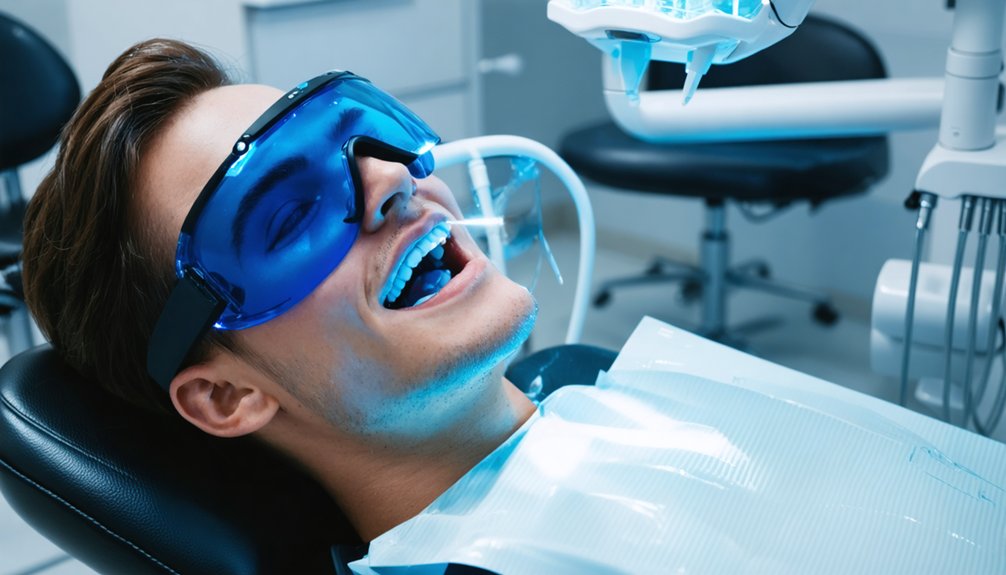
You’ll find professional LED teeth whitening treatments offer rapid results through high-concentration peroxide gels activated by specialized blue light technology in a controlled clinical setting.
At-home LED systems have evolved to provide convenient alternatives, featuring wireless mouthpieces and lower-concentration gels that balance effectiveness with comfort.
These consumer devices now incorporate advanced features like gentle warming and precision timing controls, making them suitable for maintenance and mild discoloration treatment between professional visits.
Professional LED Treatment Benefits
LED-enhanced teeth whitening treatments represent a significant advancement in professional dental cosmetics, combining high-concentration hydrogen peroxide with targeted light activation.
You’ll see measurable improvements in tooth brightness, with clinical outcomes showing up to 10 shades lighter and significant reductions in yellowness. Professional LED systems deliver superior results in a shorter treatment duration compared to at-home alternatives.
While you’ll notice immediate whitening effects, it’s important to understand that some color regression is normal in the days following treatment. Your dentist may recommend fluoride treatments to manage sensitivity, which affects 30-70% of patients.
The procedure’s effectiveness stems from LED light’s ability to accelerate peroxide decomposition, though results vary among patients based on initial tooth color and stain types.
At-Home LED Systems Evolution
Recent advances in at-home LED whitening systems have transformed the landscape of personal dental care through sophisticated light-activation technologies.
You’ll find these modern systems incorporating dual-action LED technology that combines blue light for activation with red light therapy for sensitivity reduction. The latest devices feature ergonomic, wireless mouthpieces designed for maximum comfort during your whitening sessions.
What’s particularly significant is the whitening efficacy of these systems when paired with advanced formulations. You can expect visible results of 1-4 shades lighter within weeks, approaching professional-level outcomes.
The integration of heat-activated technology with peroxide-free options means you’ll experience enhanced whitening performance while minimizing sensitivity risks. These innovations make professional-grade teeth whitening more accessible and comfortable than ever before.
Subscription-Based Whitening Services
As consumers seek more convenient dental care options, subscription-based teeth whitening services have emerged as an increasingly popular alternative to traditional in-office treatments.
You’ll find flexible plans ranging from $199 to $349 annually, offering a combination of at-home kits and professional sessions. The subscription benefits include customizable options for sensitivity levels and desired shade preferences, while providers achieve stronger customer retention through consistent engagement.
These services typically deliver whitening strips, pens, gels, or LED devices on a recurring schedule, with some plans incorporating unlimited cleanings as part of broader dental care memberships.
Modern teeth whitening subscriptions combine regular delivery of whitening products with comprehensive dental care benefits for complete smile maintenance.
You can choose from eco-friendly products with natural ingredients or opt for “whitening for life” programs that provide long-term maintenance solutions.
This model’s success reflects growing market projections reaching $3.73 billion by 2030.
Smart Device Integration in Teeth Whitening
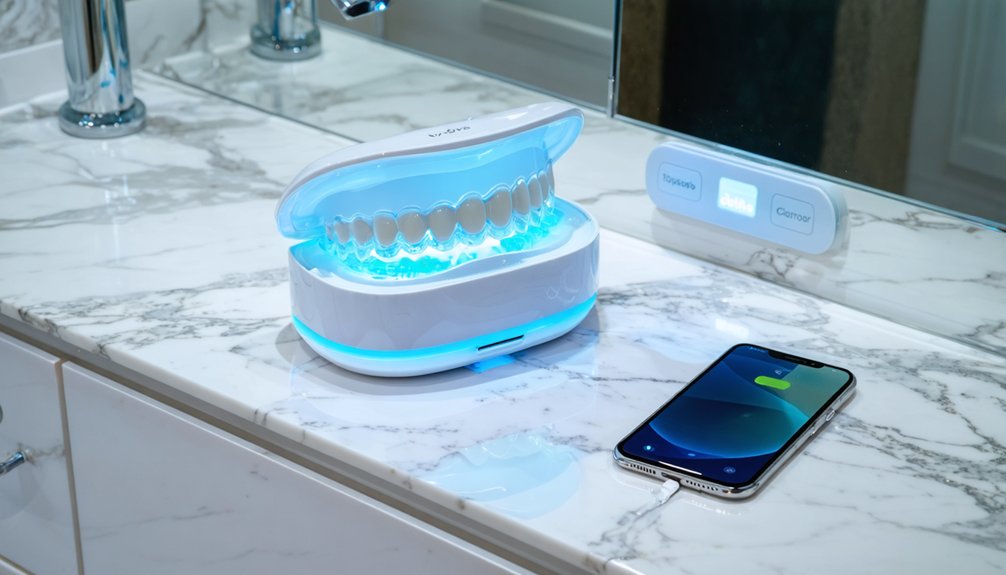
Smart technology has revolutionized teeth whitening through AI-enhanced systems that automatically adapt to your unique oral profile.
Today’s whitening innovations combine LED lights, heat activation, and real-time feedback to deliver faster, more comfortable treatments while protecting your enamel.
You’ll find these smart devices offer precision-controlled settings that adjust intensity based on your sensitivity levels and desired outcomes.
Many systems now integrate with mobile apps, allowing you to track your progress through AI-powered shade analysis and receive personalized treatment recommendations.
The combination of multi-wavelength LEDs with heat activation accelerates stain removal while minimizing sensitivity.
With Bluetooth-enabled trays and wireless mouthpieces, you can maintain mobility during treatment, making the whitening process more convenient and effective than ever before.
Eco-Friendly Whitening Products and Packaging
While traditional teeth whitening products have relied heavily on synthetic materials and excessive packaging, today’s eco-conscious consumers can choose from an expanding range of environmentally responsible options.
You’ll find eco-friendly innovations like biodegradable bamboo toothbrushes, dissolvable whitening strips, and natural whitening agents such as activated charcoal and baking soda that minimize environmental impact while maintaining effectiveness.
Sustainable materials are transforming the industry through FSC-certified packaging, recyclable components, and plastic-free alternatives.
Look for products rated 0-2 by the Environmental Working Group, indicating ideal safety and sustainability.
You can now select from melt-away masks, natural coconut oil strips, and refillable whitening pens that deliver results without compromising the planet.
These products often carry vegan and cruelty-free certifications, ensuring both ethical standards and environmental responsibility.
Frequently Asked Questions
How Long Do Teeth Whitening Results Typically Last?
Your bright smile can shine for several months to 3 years, depending on teeth staining from foods and lifestyle. You’ll need whitening frequency touch-ups every 6-12 months for lasting results.
What Foods and Drinks Should I Avoid After Teeth Whitening?
You’ll need to avoid staining beverages like coffee, tea, and red wine, plus acidic foods including citrus fruits and tomatoes. Stick to white or clear foods for 48 hours.
Can Teeth Whitening Damage Existing Dental Work Like Crowns or Veneers?
While whitening won’t damage your crowns or veneers, they won’t whiten either. Schedule a dental consultation to discuss options, as you’ll likely need restoration adjustments to match newly whitened natural teeth.
Is It Safe to Whiten Teeth While Pregnant or Breastfeeding?
You shouldn’t whiten your teeth while pregnant due to safety concerns and limited research. However, you can safely whiten while breastfeeding, as whitening agents don’t pass through breast milk in significant amounts.
What’s the Minimum Age Recommended for Teeth Whitening Treatments?
You should wait until age 18 for cosmetic teeth whitening to avoid teeth sensitivity risks. If you’re younger, consult your dental professional first, as they’ll determine if medical treatment is necessary.
References
- https://www.archivemarketresearch.com/reports/teeth-whitener-248933
- https://www.fortunebusinessinsights.com/teeth-whitening-market-110349
- https://www.futuremarketinsights.com/reports/teeth-whitening-pens-market
- https://www.rankmydentist.com/blog/oral-health/teeth-whitening-statistics-and-trends
- https://www.prnewswire.com/news-releases/teeth-whitening-market-size-to-grow-by-usd-1-27-billion-from-2025-2029–growing-awareness-among-consumers-about-importance-of-dental-aesthetics-ai-driving-market-trends—technavio-302371949.html
- https://www.globenewswire.com/news-release/2025/08/13/3132659/28124/en/Trends-Shaping-the-12-Billion-Teeth-Whitening-Industry-2025-2030-Innovative-Technologies-and-Regulatory-Updates-Transforming-the-Global-Market.html
- https://www.newmouth.com/oral-health/teeth-whitening-statistics/
- https://www.thebusinessresearchcompany.com/report/teeth-whitening-global-market-report
- https://www.varnidental.com/blog/teeth-whitening-whats-new-what-works-and-what-to-avoid
- https://www.mydentistfortcollins.com/2025-cosmetic-dentistry-trends-in-the-us-popularity-insights-and-innovations
